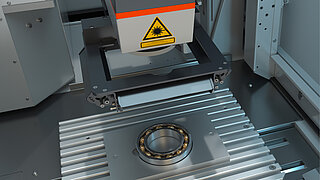Metals Laser Engraving, Etching and Marking of Metals

Laser Marking Applications of Metal
Which metals can be laser marked and engraved?
There is hardly any kind of metal that is not capable of being laser marked or laser engraved. Equally comprehensive are the processing procedures that are used for the identification and engraving of metals: They range from annealing and black marking to "simple" and three-dimensional engraving. Laser changeable images can be equally created as decorative surface structures and protecting micro engravings.
A list of metals that can be laser marked and laser engraved is long and includes the following types of metals - but also many more that might not be listed below:
Stainless steel, high-grade steel, steel, Carbon steel, Copper, Iron, ferrous metals, Magnesium, Aluminum, Brass, Gold, Silver, Platinum, Paladium, Titanium
Laser marking of stainless steel in the medical industry
There is much more to marking medical devices than just complying with regulations. Whether manufacturers have to comply with global standards and apply all ID marks reliably with repeat accuracy or whether they have to ensure product quality – all medical products have to be marked properly in the first place. To ensure correct part identification, absolutely traceable marks are indispensable. Laser marking is the ideal method to create these marks and at the same time offers an increase in production efficiency and decrease in costly product scrap.
Ultra high contrast marking on metal
Complex structures of a substrate – such as on castings in the automotive sector – may complicate the readability of the applied codes due to shadows in varying lighting conditions and therefore poor contrasts.
An optimized black/white marking results in a much better readability. High contrast can be created by marking black codes in the metal and additionally whitening the peripheral areas as well as the in-between spaces.
High-speed laser marking on aluminium can lids
FOBA's Y-series laser marking systems can easily be integrated into high-speed production lines. This allows for maintaining the required throughput speed for large batch products such as beverage cans.
Chinese can lid manufacturer Transhell provides leading beverage labels worldwide with can lids and uses a FOBA marking system to apply QR-codes and characters.
Ball bearings made of steel with black marking
Ball bearing made of typical machining steel (sulfur-free steel) with black annealing marking.
Laser marking anodized aluminum dimmer component
The marking is produced by removing the anodized layer on the aluminum using a laser.
Laser-based removal of anodized layers is a typical application in the field of apparatus engineering, to make name plates, front panels etc.
Color laser marking on stainless steel
Annealing marking allows the creation of various colors and is even appropriate for giving substrates different designs.
In medical device production, stainless steel and titanium are often in use. When even surfaces are required in order to prevent germs from penetrating, annealing is a good marking solution, because the local heating process results in color change instead of material removal. Moreover these marks are highly resistant.
The stainless steel shown here has been electro polished before marking. Different surface treatments are possible as well, like brushing or micro abrasive blasting.
Delivery pipe for a natural gas car
Annealing marking on a delivery pipe used in vehicles powered by natural gas.
Laser engraving on sprinkler head
Slight laser engraving with contrast on a sprinkler head. This marking can – unlike annealing marking that is much richer in contrast and that disappears or becomes completely black on heating over 500°C – be read even after a fire.
Black marking on aluminum
Laser causes local heating of aluminum surfaces and thus oxidation. This process is called black marking, its physical or chemical effects are still unknown. The marking results have proven to be rich in contrast and wear-resistant.
Black marking on aluminum is often used for inscriptions on smartphones or notebooks.
Best suitable for black marking on aluminum are laser systems from the FOBA Y-Series. Using the short pulsed FOBA Y.0201 ensures that there is no damage to the aluminum surface at all.
Graded white, grey and black marks on anodized aluminum
Color or material removal creates different marking effects on aluminum. Laser removes parts of or the complete anodized top layer.
Anodizing processes produce a ceramic layer (5 to 30 µm) on aluminum which ensures protection and scratch resistance of the surface. The porous layer can be colored and thus can result in decorative marking effects. Marking results differ depending on the laser wavelength (and thus thickness of removed material) and on the coloration of the underlying layers.
Anodized aluminum is frequently applied in machine-building, e. g. for machine housing parts, covers, adjusting screws etc.
FOBA lasers of the Y-Series (such as the Y.0100, Y.0200, Y.0300) are suitable for the marking of anodized aluminum.
Surface structuring with lasers
Laser engraving can be used for structuring metal surfaces. The micro-structures (honeycombs, stars, waves, circles etc.) on the brass plate were engraved by a fiber laser at a depth of 0,34mm. For example, this kind of haptic surface structuring can be used for the decorative design of bathroom fittings.
Material: brass
Laser marker: 20 Watt fiber laser
Engraving depth: 0,34 mm